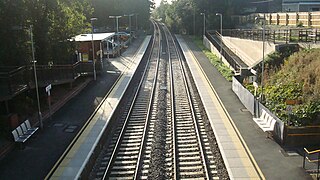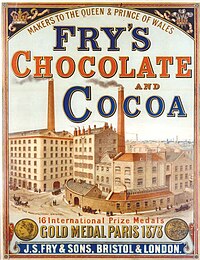
Chocolate or cocoa is a food made from roasted and ground cacao seed kernels that is available as a liquid, solid, or paste, either on its own or as a flavoring agent in other foods. Cacao has been consumed in some form for at least 5,300 years starting with the Mayo-Chinchipe culture in what is present-day Ecuador and later Mesoamerican civilizations also consumed chocolate beverages before being introduced to Europe in the 16th century.

Cadbury, formerly Cadbury's and Cadbury Schweppes, is a British multinational confectionery company owned by Mondelez International since 2010. It is the second-largest confectionery brand in the world, after Mars. Cadbury is internationally headquartered in Greater London, and operates in more than 50 countries worldwide. It is known for its Dairy Milk chocolate, the Creme Egg and Roses selection box, and many other confectionery products. One of the best-known British brands, in 2013 The Daily Telegraph named Cadbury among Britain's most successful exports.

A chocolate bar is a confection containing chocolate, which may also contain layerings or mixtures that include nuts, fruit, caramel, nougat, and wafers. A flat, easily breakable, chocolate bar is also called a tablet. In some varieties of English and food labeling standards, the term chocolate bar is reserved for bars of solid chocolate, with candy bar used for products with additional ingredients.

Keynsham is a town and civil parish located between Bristol and Bath in Somerset, England. It had a population of 19,603 at the 2021 Census. It was listed in the Domesday Book as Cainesham, which is believed to mean the home of Saint Keyne.

Milk chocolate is a form of solid chocolate containing cocoa, sugar and milk. It is the most consumed type of chocolate, and is used in a wide diversity of bars, tablets and other confectionery products. Milk chocolate contains smaller amounts of cocoa solids than do dark chocolates, and contains milk solids. While its taste has been key to its popularity, milk chocolate was historically promoted as a healthy food, particularly for children.

Coenraad Johannes van Houten was a Dutch chemist and chocolate maker known for the treatment of cocoa mass with alkaline salts to remove the bitter taste and make cocoa solids more water-soluble; the resulting product is still called "Dutch process chocolate". He is also credited with introducing a method for pressing the fat from roasted cocoa beans, though this was in fact his father, Casparus van Houten's invention.
Crunchie is a brand of chocolate bar with a honeycomb toffee centre. It is made by Cadbury but was originally launched in the UK by J. S. Fry & Sons in 1929.

Green & Black's is a British chocolate company founded in 1991. The company produces a range of organic food products, including: chocolate bars, ice cream, biscuits and hot chocolate.

Keynsham railway station is on the Great Western Main Line in South West England, serving the town of Keynsham, Somerset. It is 113 miles 63 chains (183.1 km) down the line from London Paddington and is situated between Oldfield Park and Bristol Temple Meads stations.

Nestlé UK Ltd., trading as Rowntree's, is a British confectionery brand and a former business based in York, England. Rowntree developed the Kit Kat, Aero, Fruit Pastilles, Smarties brands, and the Rolo and Quality Street brands when it merged with Mackintosh's in 1969 to form Rowntree Mackintosh Confectionery. Rowntree's also launched After Eight thin mint chocolates in 1962. The Yorkie and Lion bars were introduced in 1976. Rowntree's also pioneered the festive selection box which in the UK have been a staple gift at Christmas for over a century.
Cecil Roderick Fry (1890–1952) was a member of the Fry family who ran the J. S. Fry & Sons confectionery business after the First World War.

Joseph Storrs Fry (1767–1835) was an English chocolate and confectionery manufacturer and a member of the Fry Family of Bristol, England.

Fry's Chocolate Cream is a chocolate bar developed by J. S. Fry & Sons and currently manufactured by Cadbury. Launched in 1866—nineteen years after Fry's created the first moulded, solid chocolate eating bar — Fry's Chocolate Cream is the first mass-produced chocolate bar and is the world's oldest chocolate bar brand.

Terry's is a British chocolate and confectionery brand. The original company was founded in 1767 in York, England, and was part of the city's famous confectionery triumvirate along with Rowntree's and Cravens. The company's headquarters and factory, Terry's Chocolate Works, was closed by Kraft in 2005 and production moved to Kraft factories in Europe. The business returned to the UK in 2019 as Terry's Chocolate Co located in London. Their best known products include Terry's Chocolate Orange and Terry's All Gold box of assorted chocolates which were both introduced in the 1930s.

The history of chocolate dates back over 5,000 years. The cacao tree is native to the tropics of the Americas. The cocoa bean was first domesticated at least 5,300 years ago in what is present-day southeast Ecuador by the Mayo-Chinchipe culture, before being introduced in Mesoamerica. Originally prepared as a drink, chocolate was served as a bitter liquid, mixed with spices or corn puree. In Mesoamerica, it was believed to be an aphrodisiac and to give the drinker strength. Today, such drinks are also known as "Chilate" and are made by locals in the south of Mexico and the north triangle of Central America. After its arrival to Europe in the sixteenth century, sugar was added to it and it became popular throughout society, first among the ruling classes and then among the common people. In the 20th century, chocolate was considered essential in the rations of United States soldiers during war.

Somerdale was a chocolate factory located in Keynsham near Bristol in South-west England, closed by Kraft foods in 2011. It was the home of a Cadbury plc production facility, and was originally built by the Fry family when they expanded through consolidation of a number of existing facilities located in the centre of Bristol.

E. Wedel is a Polish confectionery company, which has been producing a variety of chocolates, cakes, and snacks since 1851. Wedel is also a well-recognized brand of candy in Poland, considered to be the "Polish national chocolate brand" in that market, and is the leading candy brand among Polish producers with about 14% of the Polish market in 2005 and 11.7% in 2007.
Joseph Fry was an English type-founder and chocolate maker, founding the family chocolate company that would later become J. S. Fry & Sons, and founder of the Bristol branch of the Quaker Fry family. He was the first member of his family to settle in Bristol, where he acquired a considerable medical practice, and 'was led to take a part in many new scientific undertakings'.
Mondelez International, Inc., styled as Mondelēz International, is an American multinational confectionery, food, holding, beverage and snack food company based in Chicago. Mondelez has an annual revenue of about $26.5 billion and operates in approximately 160 countries. It ranked No. 108 in the 2021 Fortune 500 list of the largest United States corporations by total revenue.
Cadbury is a British multinational confectionery company owned by Mondelēz International. It is the second largest confectionery brand in the world after Mars. Cadbury is headquartered in Uxbridge, London, and operates in more than fifty countries worldwide. Its best known products include Dairy Milk chocolate.






















